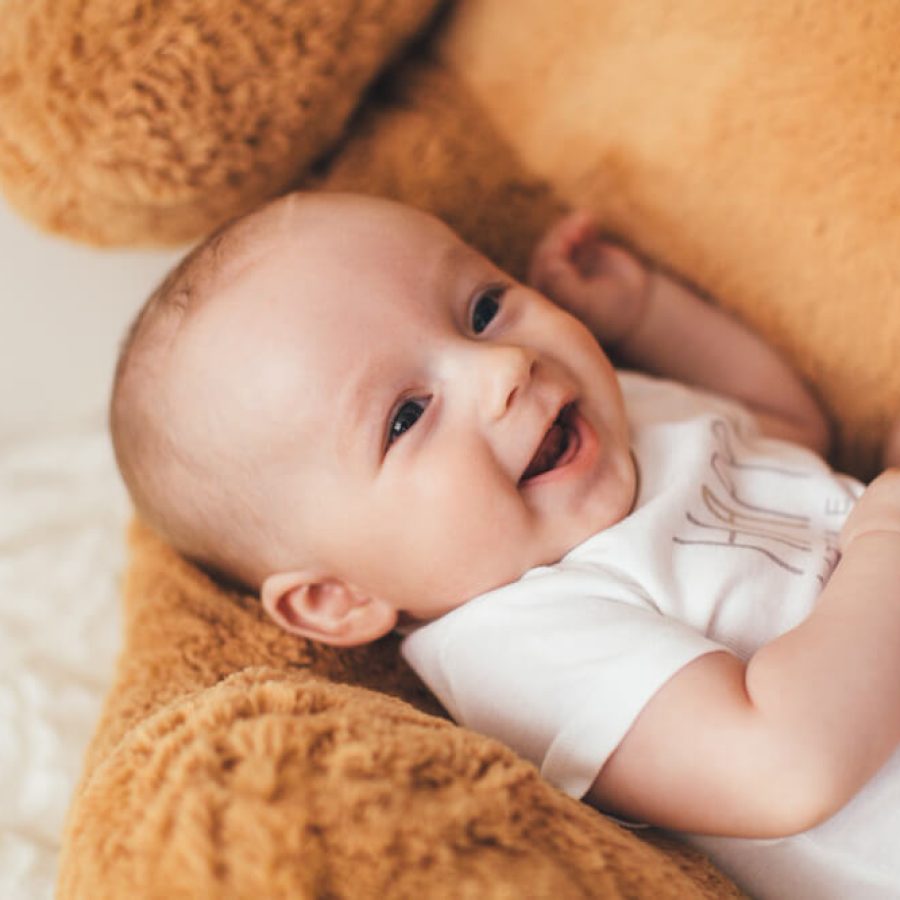Laughter is one of the earliest and most precious ways babies communicate joy. That first giggle is more than just a heartwarming milestone, as it represents a sign of growth, connection, and learning.
As babies respond to playful interactions, they discover the joy of shared experiences. But laughter isn’t just about fun; it plays a vital role in a child’s development, strengthening social bonds, enhancing brain function, and even supporting future communication skills.
By encouraging laughter through play, parents nurture their baby’s emotional and cognitive growth, laying the foundation for a happy, healthy childhood.
In this article, we’ll explore when babies start laughing, why this is an important achievement, and how to support that sparkle of joy.
When Do Infants Typically Start Laughing?
Smiling and laughing are developmental milestones, so they’re both very much appreciated.
By the time your baby is 4 months old, they might be able to chuckle and put on a big smile when stimulated. However, full-on laughter is expected by 6 months old, according to the CDC (Centers for Disease Control and Prevention).
Naturally, it could happen sooner than that! However, this is the expected timeline from smiling to laughter (based on the CDC):
- 2 months old: baby smiles when talked or smiled to; makes other sounds than crying.
- 4 months old: smiles on their own to get your attention; chuckles; makes cooing noises like “aaah” or “ooooh”.
- 6 months old: laughs; makes squealing noises; blows raspberries (which is a great sign, because it shows the baby is learning to use their tongue and mouth to produce different sounds).
What Makes Babies Laugh?
It takes time until newborns can get a sense of humor and actually find anything legitimately funny. As shown, during their first 2 to 4 months old, they basically smile as a response to your behavior. They don’t smile because they think you’re funny, but because they understand they get your attention when doing so!
Also, other forms of stimuli such as bouncing them on your knees could cause them to chuckle and make their first attempts to laugh.
However, smiling has a positive effect on our bodies and minds, and the same is true with our Little Ones. Just as we feel good after a good laughter, or could be influenced to laugh when we see someone else do it, it happens similarly with babies.
Okay, so we want to stimulate that good sensation! How do we do it?
Funny Facial Expressions
- Babies are fascinated by faces, especially their parents’ expressions. Exaggerated expressions, like wide-open eyes, puffed cheeks, or a goofy tongue-out look, can make them giggle.
- Try raising your eyebrows, pretending to be surprised, or making silly faces in a mirror.
Gentle Tickling
- Lightly tickling the baby’s tummy, feet, or under their chin can trigger laughter. Babies have sensitive skin and react to gentle touches with smiles and giggles.
Silly Sounds While Interacting
- Changing your voice while talking to them (deep, squeaky, whispering) can surprise and amuse them.
- Pretend to “nibble” their fingers with soft, playful “nom nom” sounds.
Sibling or Pet Interaction
- Older siblings who dance, make silly faces, or play “hide and seek” can bring out laughs.
- Watching a gentle pet wag its tail or do playful movements is often amusing to babies.
Why Laughter Is Important for Development
Laughter is more than just a joyful sound: it plays a crucial role in a baby’s development.
Encouraging laughter helps nurture their emotional, cognitive, and social growth in several ways:
Supports Speech Development
Strengthens facial and oral muscles, helping with future speech and communication skills.
Boosts Feel-Good Brain Chemicals
Releases endorphins and reduces stress, creating positive emotional connections.
Signals Developmental Milestones
Shows that babies are recognizing patterns, engaging with social cues, and responding to stimuli.
Fosters Social Bonds
Strengthens connections with parents and caregivers, reinforcing feelings of safety and trust.
Encourages Emotional Intelligence
Helps babies build an emotional repertoire by recognizing and responding to different emotions.
Enhances Cognitive Growth
Engages brain activity, supporting problem-solving, curiosity, and early learning.
Reduces Stress and Promotes Well-Being
Lowers cortisol levels, improves sleep, and strengthens the immune system.
Encourages Playfulness and Creativity
Laughter often happens through play, helping babies explore the world with curiosity and confidence.
By celebrating and encouraging laughter, parents are creating happy moments while actively shaping their baby’s development in a meaningful and lasting way.
What If Your Baby Hasn’t Laughed Yet?
You can expect your baby to laugh by the time they’re 6 to 7 months old.
However, don’t worry excessively if your child happens to have a different rhythm. As always, every child has their own pace during development.
If it so happens that your Little One doesn’t show any signs of laughter or the aforementioned developmental milestones until the 7th month of age, seek specialized help by contacting your pediatrician.
To encourage it, do your best to engage the child: if you want your child to laugh, ensure you’re also doing that! Make sounds, voices, faces, show them different textures (as long as they’re safe).
All of this will build into an emotional repertoire, and at the right time, your baby will be full of expressions and feelings to share!
Encouraging Infants to Have Their First Laughs
Final note: always communicate with your Little One—tell them stories, show them what you’re doing, introduce them to friends and family. All of these interactions are absorbed and processed, which is especially important during the first 5 years.
By now, you know when infants start to laugh, and how to easily encourage that. The trick, as well as being a devoted parent who offers lots of love, is setting up the example and stirring laughter!
Since we’re on the topic of what children need to develop, continue reading and learn when children start swimming!


